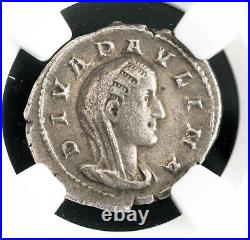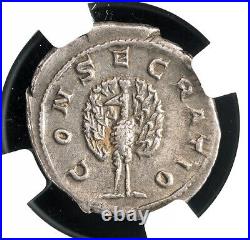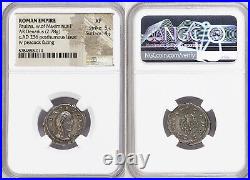



Diva Paulina (235-236 AD) Beautiful Silver Denarius “Peacock” Coin. Mint Place: Rome Mint Year: 236 AD Denomination: Gold Franc ” on foot” References: Duplessy 360 Friedberg 284. Certified and graded by NGC as XF 5/5, 4/5. Ruler (Emperor): Caecilia Paulina (a posthumous strike in the name of Caecilia Paulina, the wife of Maximinus I Thrax who died before or shortly after her husband’s accession to the throne). Diameter: 21mm Weight: 2.78gm Material: Silver. Obverse: Veiled and draped bust of Caecilia Paulina as Diva Paulina (the term Diva = “Divine” is preserved for all persons in who´s name posthumous coins were issued) right. Reverse: Peacock with spread tail, standing facing, head left. As with many other empresses of the later Roman Empire, very little is known about Caecilia Paulina, wife of Maximinus I Thrax. Maximinus is said to have worn his wife’s bracelet as a ring on his thumb, an anecdote intended to emphasize his enormous size. Paulina died either before her husband’s accession or shortly thereafter, as all her coins are posthumous and name her as Diva, or goddess. Some of her portraits appear to be feminized versions of her husband, although this example has a more delicate and distinctive visage. (died in 235/236) was a Roman Empress and consort to Emperor Maximinus Thrax, who ruled in 235-238. Her full titulature, Diva Caecilia Paulina Pia Augusta, is preserved on an inscription (CIL X, 5054). On her coins she is termed simply Diva Paulina. The coins with her inscription were not struck during her life, but some time later, probably after she was deified. No sculptural likenesses of her survive. Almost nothing is known about her life, as ancient writers rarely mentioned her by name. Her husband never set foot in Rome, thus it is likely that neither did she, at least in her time married to the Emperor. She lived during the Crisis of the Third Century, a time of the crumbling and near collapse of the Roman Empire, caused by three simultaneous crises: external invasion, internal civil war, and economic collapse. While the 4th century historian Ammianus Marcellinus wrote about Paulina in his book on the Gordian emperors, this part of his work was lost, only the sections of his History covering the period 353-378 are extant. In a later passage, however, Marcellinus refers to the Empress as the good wife of the difficult husband who had. Led him back into the paths of truth and mercy, by feminine gentleness, as, in recounting the acts of the Gordiani, we have related to have been done by the wife of that truculent emperor Maximinus. Paulina had one son, Gaius Julius Verus Maximus, appointed Caesar in 236 by his father, but both men were murdered by the soldiers in May 238. Paulina probably died around late 235 or early 236, as Maximus had her deified in 236. The city of Anazarbus in Cilicia struck coins in the name of “Thea Paulina” (the Greek equivalent of “Diva Paulina”), and dated them to the year 254 of that city’s era which converts to 235/236 of the modern calendar. That Paulina is referred to as divine on the coins indicates that she was dead when the coins were produced. Joannes Zonaras claims that Maximinus executed his wife, but that accusation is unproven, and improbable if she was deified by her husband. Gaius Julius Verus Maximinus ” Thrax ” “the Thracian”. 173 – 238 was Roman emperor from 235 to 238. His father was an accountant in the governor’s office and sprang from ancestors who were Carpi (a Dacian tribe), a people whom Diocletian would eventually drive from their ancient abode (in Dacia) and transfer to Pannonia. Maximinus was the commander of the Legio IV. When Severus Alexander was assassinated by his own troops in 235. The Pannonian army then elected Maximinus emperor. In 238 (which came to be known as the Year of the Six Emperors), a senatorial revolt broke out, leading to the successive proclamation of Gordian I, Gordian II, Pupienus, Balbinus and Gordian III as emperors in opposition to Maximinus. Maximinus advanced on Rome to put down the revolt, but was halted at Aquileia, where he was assassinated by disaffected elements of the Legio II. Maximinus is described by several ancient sources, though none are contemporary except Herodian’s. He was a so-called barracks emperor of the 3rd century; his rule is often considered to mark the beginning of the Crisis of the Third Century. Maximinus was the first emperor who hailed neither from the senatorial class nor from the equestrian class. This item is in the category “Coins & Paper Money\Coins: Ancient\Roman: Imperial (27 BC-476 AD)”. The seller is “coinworldtv” and is located in this country: AT. This item can be shipped worldwide.
- Cleaned/Uncleaned: Uncleaned
- Country/Region of Manufacture: Italy
- Certification Number: 5784858014
- Certification: NGC
- Date: 263 AD
- Grade: XF
- Year: 236 AD
- Composition: Silver
- Ruler: Maximinus Thrax
- Historical Period: Roman: Imperial (27 BC-476 AD)
- Denomination: Denarius
- KM Number: See detailed description section for full data!
- Era: Ancient

